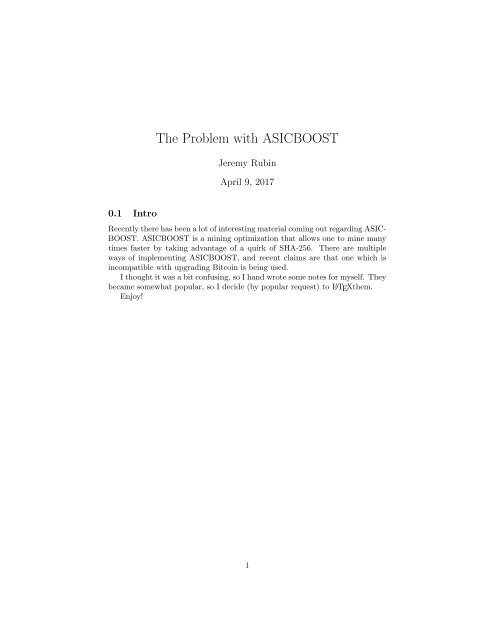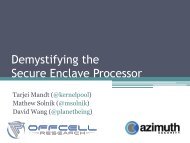The Problem with ASICBOOST
NrVcQ8
NrVcQ8
You also want an ePaper? Increase the reach of your titles
YUMPU automatically turns print PDFs into web optimized ePapers that Google loves.
<strong>The</strong> <strong>Problem</strong> <strong>with</strong> <strong>ASICBOOST</strong><br />
Jeremy Rubin<br />
April 9, 2017<br />
0.1 Intro<br />
Recently there has been a lot of interesting material coming out regarding ASIC-<br />
BOOST. <strong>ASICBOOST</strong> is a mining optimization that allows one to mine many<br />
times faster by taking advantage of a quirk of SHA-256. <strong>The</strong>re are multiple<br />
ways of implementing <strong>ASICBOOST</strong>, and recent claims are that one which is<br />
incompatible <strong>with</strong> upgrading Bitcoin is being used.<br />
I thought it was a bit confusing, so I hand wrote some notes for myself. <strong>The</strong>y<br />
became somewhat popular, so I decide (by popular request) to L A TEXthem.<br />
Enjoy!<br />
1
0.2 Basics<br />
A Bitcoin Header looks like this:<br />
0 4 36 68 72 76 80<br />
V<br />
E<br />
R<br />
S<br />
I<br />
O<br />
N<br />
PREVIOUS BLOCK<br />
MERKLE ROOT<br />
T<br />
I<br />
M<br />
E<br />
N<br />
B<br />
I<br />
T<br />
S<br />
N<br />
O<br />
N<br />
C<br />
E<br />
A SHA-256 Hash of 80-Bytes looks like this:<br />
0 64 128<br />
Data Data padding: 0x80. . . 00<br />
S<br />
I<br />
Z<br />
E<br />
Chunk 1 Chunk 2<br />
<strong>The</strong> Hash computation has the following control flow:<br />
S 0 Chunk 1<br />
Chunk 2<br />
Preprocess<br />
S 1<br />
Chunk 1<br />
S 2<br />
Preprocess<br />
Chunk 2<br />
2
1 Reduced Work Updates<br />
<strong>ASICBOOST</strong> takes advantage of the following reductions in work if you modify<br />
the first or second half of the header only. In the following diagrams, I’ve blacked<br />
out parts that aren’t recomputed.<br />
Modifying only chunk 1 gives a small improve-<br />
Modifying Chunk 1 Only<br />
ment.<br />
S 0 Chunk 1<br />
Chunk 2<br />
Preprocess<br />
S 1<br />
Chunk 1<br />
S 2<br />
Preprocess<br />
Chunk 2<br />
Modifying only chunk 2 gives a huge improve-<br />
Modifying Chunk 2 Only<br />
ment.<br />
S 0 Chunk 1<br />
Chunk 2<br />
Preprocess<br />
S 1<br />
Chunk 1<br />
S 2<br />
Preprocess<br />
Chunk 2<br />
3
1.1 How do headers get hashed?<br />
Let’s juxtapose the header and hash alignment.<br />
0 4 36 64 68 72 76 80 128<br />
Chunk 1 Chunk 2<br />
Data Data padding: 0x80. . . 00<br />
S<br />
I<br />
Z<br />
E<br />
V<br />
E<br />
R<br />
S<br />
I<br />
O<br />
N<br />
PREVIOUS BLOCK<br />
MERKLE ROOT<br />
T<br />
I<br />
M<br />
E<br />
N<br />
B<br />
I<br />
T<br />
S<br />
N<br />
O<br />
N<br />
C<br />
E<br />
<strong>The</strong> Merkle root commitment is in both chunk 1 and chunk 2. <strong>The</strong> first 28<br />
Bytes are in chunk 1, the remaining 4 bytes are in chunk 2.<br />
1.1.1 What is in the Merkle root?<br />
At each level, the hash of the concatenated strings is computed. Each letter<br />
A . . . H is the hash of a transaction. <strong>The</strong> node ABCDEF GH is called the<br />
merkle root.<br />
ABCD<br />
EFGH<br />
AB<br />
CD<br />
EF<br />
GH<br />
AB CD EF GH<br />
A B C D E F G H<br />
If any of the underlying data A . . . H are either modified or reordered, the<br />
4
Merkle root will have a different value (uniformly random).<br />
1.2 What if we find two merkle roots <strong>with</strong> the same last<br />
4 bytes?<br />
Now we can run our very efficient algorithm to only modify chunk 2 on many<br />
precomputed chunk 1s.<br />
Chunk 1 A<br />
Chunk 2<br />
Chunk 1 A<br />
Preprocess<br />
Chunk 1 A<br />
Preprocess<br />
Chunk 2<br />
Preprocess<br />
Chunk 1 B<br />
S A,1<br />
S A,2<br />
S 0 S B,2 S B,1 S 0<br />
So now for a little extra setup work, we get a 2× hash rate multiplier for every<br />
nonce we try in chunk 2. <strong>The</strong> below diagram shows the part that doesn’t need<br />
to be recomputed.<br />
Chunk 1 A<br />
Chunk 2<br />
Chunk 1 A<br />
Preprocess<br />
Chunk 1 A<br />
Preprocess<br />
Chunk 2<br />
Preprocess<br />
Chunk 1 B<br />
S A,1<br />
S A,2<br />
S 0 S B,2 S B,1 s0<br />
If we find N chunk 1s, we can use the same trick for an N× hash rate<br />
multiplier.<br />
5
2 Practical Collision Generation<br />
How do we generate colliding (in the last 4 bytes) transaction tree Merkle commitments<br />
efficiently?<br />
2.1 Birthday Paradox<br />
<strong>The</strong> Birthday Paradox says that if 23 people are in a room, there is a 50%<br />
chance that at least two people share a birthday.<br />
This is the same problem as our tree collision, but <strong>with</strong> different numbers.<br />
It works because as the number of people increases, the number of independent<br />
chances of sharing a birthday increases more quickly.<br />
You can visualize this as counting the number of connections in the following<br />
graphs. <strong>The</strong>se represent independent chances to share a birthday between nodes.<br />
<strong>The</strong> closed form for the number of connections for n nodes is ( )<br />
n =<br />
n!<br />
n·(n−1)<br />
2<br />
= O(n 2 ) chances<br />
2.1.1 Generalized Birthday Paradox<br />
2<br />
2·(n−2)! =<br />
A general closed formula for computing the number E of entries of T types<br />
needed to be P probable to have a C-way collision is hard to find, but the<br />
following approximation works well as an upper bound 1 .<br />
P ≈ 1 − e −(E C)T −C+1<br />
For instance, for the standard birthday paradox problem:<br />
2.2 Summary<br />
P ≈ 0.5 ≈ 1 − e −(23 2 )365 −2+1<br />
It’s clear that the key in collision hunting is to store and generate a large number<br />
of potential matches to compare against. <strong>The</strong> probability of a collision becomes<br />
very likely even <strong>with</strong> a large set of possible ”birthdays” (T ), and relatively small<br />
numbers of ”people” (E).<br />
Using our formula, for 4 bytes of potential ”birthdays”, at 110k ”people”,<br />
the probability of a shared ”birthday” is more than 75%.<br />
1 − e −(110k 2 )(2 32 ) −1 > 0.75<br />
1 It should over-count. See<br />
https://math.stackexchange.com/questions/25876/probability-of-3-people-in-a-room-of-30-having-the-same-birthday<br />
6
Creating a last 4 bytes colliding Merkle tree commitments is now reduced<br />
to a problem of generating 110k unique transaction commitment merkle roots.<br />
3 Generating N Unique Merkle Trees<br />
3.1 Naive Algorithm<br />
We can generate a unique Merkle tree by changing one of the base nodes.<br />
ABCD<br />
EFGH<br />
AB<br />
CD<br />
EF<br />
GH<br />
AB CD EF GH<br />
A B C D E F G H<br />
ABC’D<br />
EFGH<br />
AB<br />
C’D<br />
EF<br />
GH<br />
AB C’D EF GH<br />
A B C D E F G H<br />
<strong>The</strong> non-blacked out boxes all need to be recomputed when changing C →<br />
C ′ . Let m be the number of leaf nodes, the naive algorithm requires O(N log m)<br />
hashes.<br />
7
3.2 Higher Order Permutations<br />
Instead, we can do higher-order permutations<br />
EFGH<br />
ABCD<br />
EF<br />
GH<br />
AB<br />
CD<br />
EF<br />
GH<br />
AB<br />
CD<br />
E<br />
F G H A B C D<br />
Now we only need to do one re-computation to get a second potential match.<br />
If we black out the ones that don’t need recomputing we see clearly this is better<br />
EFGH<br />
ABCD<br />
EF<br />
GH<br />
AB<br />
CD<br />
EF<br />
GH<br />
AB<br />
CD<br />
E<br />
F G H A B C D<br />
In the naive version, each new potential match is expensive to computer. In<br />
the smarter version, we can recursively apply this principal to very efficiently<br />
generate potential matches.<br />
<strong>The</strong>re are several strategies for generating candidates, not just swapping.<br />
Swapping isn’t optimal because Bitcoin transactions have order dependencies,<br />
but it is demonstrative of the principles at play.<br />
8
3.3 Efficient Algorithm<br />
Let’s say we want to generate R collisions, and the birthday paradox says it is<br />
likely <strong>with</strong> N hashes.<br />
First, we generate √ N unique left hand sides and √ N unique right hand<br />
sides (i.e., A α , B β where α, β ∈ 1 · · · √N).<br />
Aα Aα A α<br />
Aα Aα<br />
Aα Aα<br />
Aα<br />
Bβ Bβ B β<br />
Bβ Bβ<br />
Bβ Bβ<br />
Bβ<br />
With our √ N A α s and B β s, we can generate N candidates by combining<br />
each A α <strong>with</strong> each B β . <strong>The</strong> diagram below illustrates the combination process.<br />
Merkle<br />
Root<br />
Candidates<br />
Merkle<br />
Root<br />
Candidates<br />
A α Aα A α−5<br />
Bβ Bβ B β<br />
Bβ Bβ<br />
Bβ−1<br />
A α Aα A α−5<br />
Bβ Bβ B β<br />
Bβ Bβ−2<br />
Aα Aα A α<br />
Aα Aα<br />
B β<br />
Aα Aα A α<br />
Aα Aα<br />
B β Bβ<br />
We can apply this recursvely: to generate √ N A α s, we generate<br />
√√<br />
N<br />
left hand sides and right hand sides. In the base case, we can modify a single<br />
transaction or swap two trivially independent transactions to generate a unique<br />
parent.<br />
This algorithm uses Θ(N) work. This is optimal (for this component of the<br />
algorithm), because we need to produce N hashes.<br />
9
3.3.1 Complexity Proof<br />
For the interested:<br />
At each step we must do n work to create the outputs, and we recurse on 2<br />
times the square root of the output size. <strong>The</strong>refore, our recurrence is:<br />
Let<br />
Substitute n <strong>with</strong> 2 p<br />
This is Case 3 of Master <strong>The</strong>orem:<br />
T (n) = 2 · T ( √ n) + n<br />
n = 2 p<br />
T (2 p ) = 2 · T ( √ 2 p ) + 2 p<br />
T (2 p ) = 2 · T (2 p/2 ) + 2 p<br />
S(p) = T (2 p )<br />
S(p) = 2 · S(p/2) + 2 p<br />
S(p) = Θ(2 p )<br />
S(p) = T (2 p )<br />
T (2 p ) = Θ(2 p )<br />
p = log n<br />
T (n) = Θ(n)<br />
This algorithm is also ”Embarrassingly Parallel”, so can get efficiency gains<br />
using multiple cores.<br />
3.4 N-Way Hit<br />
Our earlier approximation predicts that in order to be likely to produce a 4-way<br />
collision we need to generate around 2 25 hashes, and store them for collision<br />
detection. This is about a gigabytes worth, so most computers should be able<br />
to generate this quickly.<br />
0.49 ≈ 1 − e −(225 4 )(2 32 ) −3<br />
A 5-way and greater, the amount of time required to generate a collision will<br />
increase markedly, but I would imagine that miners <strong>with</strong> <strong>ASICBOOST</strong> would<br />
not want to use that, and prefer to generate many 4-way collisions <strong>with</strong> rolled<br />
coinbase extra-nonces.<br />
10
4 What does Segregated Witness (SegWit) have<br />
to do <strong>with</strong> it?<br />
In SegWit we generate an additional commitment of all the signatures and we<br />
put it into the coinbase transaction.<br />
This commits to which transactions are present in the block and in what<br />
order they appear, which means no more easy generation of unique Merkle<br />
roots; the commitment is in the leftmost transaction, so modifying the order or<br />
contents of any transaction triggers a full a factor of log m rehash.<br />
<strong>The</strong> figures below demonstrates this. A commits to BCDEF GH. Any<br />
change in the order or contents of the tree triggers the update to A’s nested<br />
commitment, which also triggers an update to ABCDEF GH. Note the direction<br />
of the arrows for the witness commitment.<br />
ABCD<br />
EFGH<br />
AB<br />
CD<br />
EF<br />
GH<br />
AB CD EF GH<br />
A B C D E F G H<br />
BC DE FG<br />
BC<br />
DE<br />
FGH<br />
Witness<br />
Commit<br />
11
5 Are SegWit and <strong>ASICBOOST</strong> are fundamentally<br />
incompatible?<br />
No.<br />
Recall 0 4 our header format. . . 36 68 72 76 80<br />
V<br />
E<br />
R<br />
S<br />
I<br />
O<br />
N<br />
PREVIOUS BLOCK<br />
MERKLE ROOT<br />
T<br />
I<br />
M<br />
E<br />
N<br />
B<br />
I<br />
T<br />
S<br />
N<br />
O<br />
N<br />
C<br />
E<br />
<strong>The</strong> version field can be used to make ”collisions” trivialy!<br />
Simply set it to a different value.<br />
5.1 Why go through the trouble of finding non-trivial collisions?<br />
• Changing versions is easy to detect.<br />
• Version is already used for. . . versions.<br />
12
6 How can we fix this?<br />
<strong>The</strong>re are a few options:<br />
1. Don’t do anything<br />
• Pro: Any changes to Bitcoin are dangerous.<br />
• Con: Status Quo is obviously harming Bitcoin.<br />
2. Change SegWit to be compatible <strong>with</strong> <strong>ASICBOOST</strong><br />
• Pro: If we could start over, it would be easy to do.<br />
• Con: Segwit is already written, reviewed, and adopted in industry.<br />
3. Block just undetectable <strong>ASICBOOST</strong><br />
• Pro: Solves the immediate problem.<br />
• Con: We wouldn’t be blocking it because undetectable optimization<br />
is wrong, but because this specific optimization intereferes <strong>with</strong> protocol<br />
development. <strong>The</strong> propensity to conflate the two is dangerous.<br />
4. Block all <strong>ASICBOOST</strong><br />
• Pro: <strong>ASICBOOST</strong> is not available to all miners, this levels the field.<br />
• Con: A dangerous precedent to set. Picking winners and losers.<br />
5. Hard fork Bitcoin to a new header format<br />
• Pro: Could leave <strong>ASICBOOST</strong> intact, put SegWit commitment in<br />
header, and everything else on the Bitcoin Hard-Fork Wish List.<br />
• Con: Dangerous precedent, risk to split network.<br />
13








